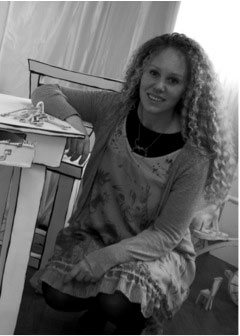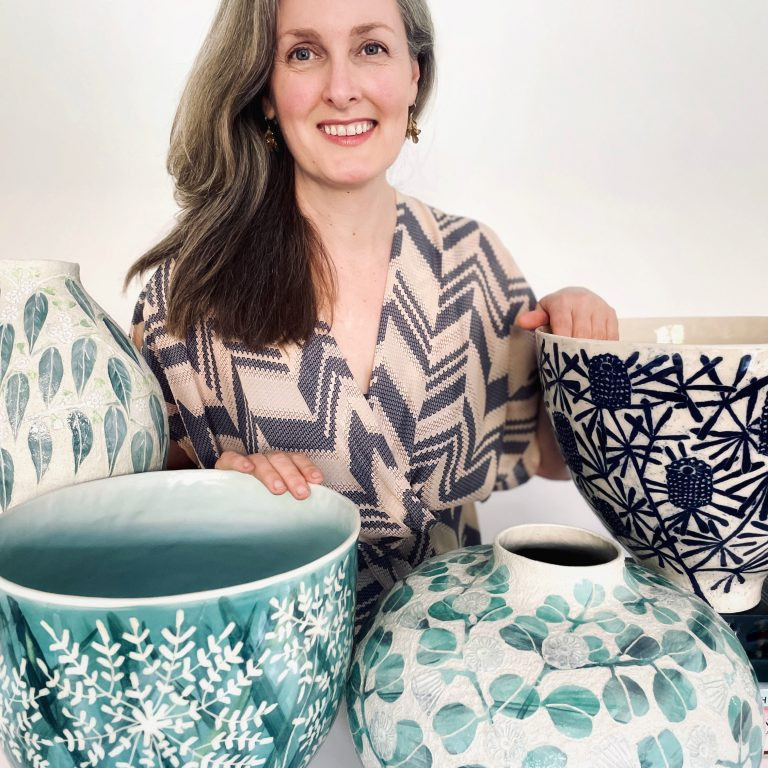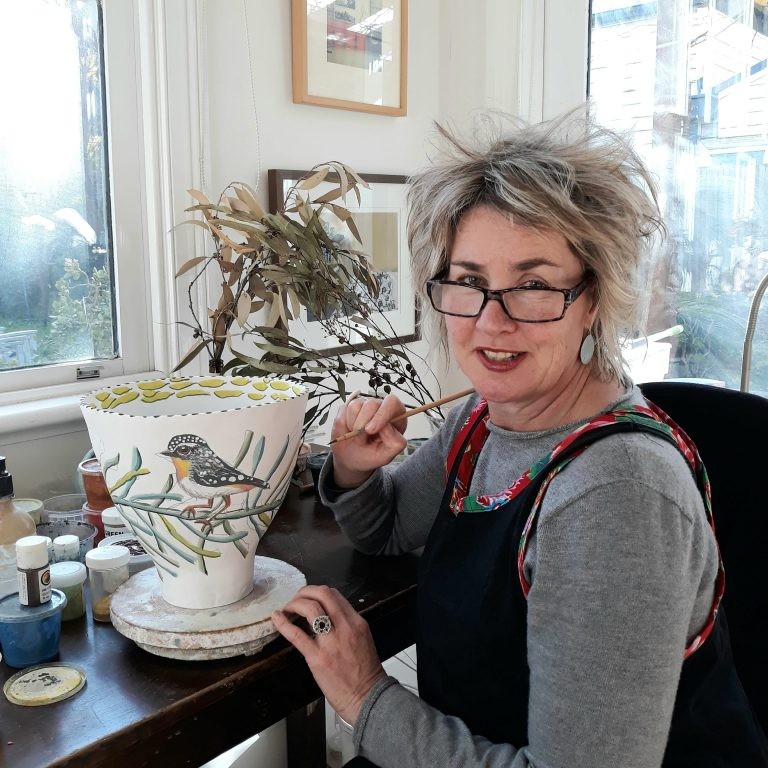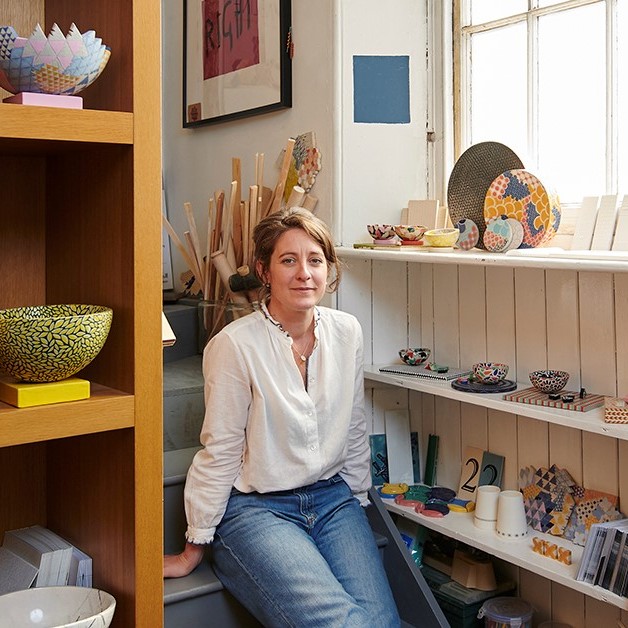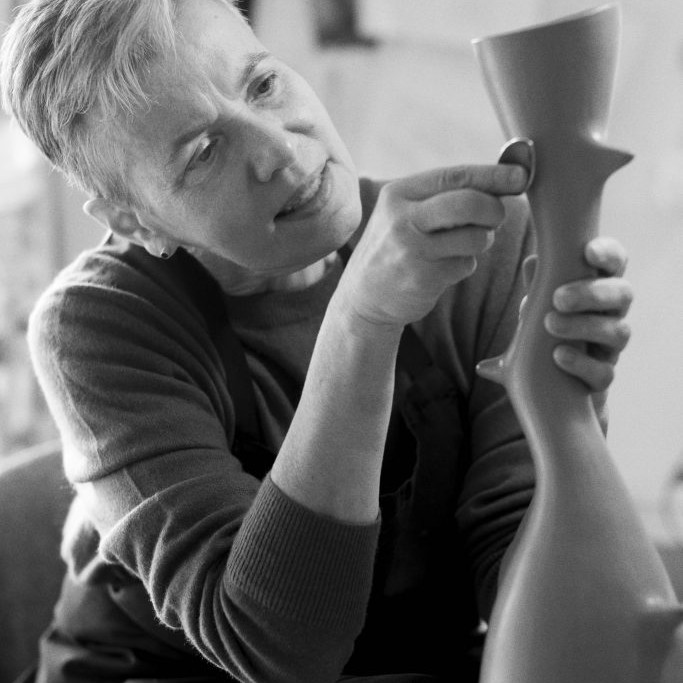Katharine Morling Ceramic Artist - London, UK
You see each of your pieces as being “embedded with stories” – can you take this further?
For me, the starting point for each piece is entirely personal, for example ‘A Stitch in Time’ is about my childhood memory of getting a wicker basket that I then turned into a sewing case, which led to hours of making and creativity.
I was particularly pleased with how the keys came out, the heat of the kiln had moved the keys just enough to create a sensation of how I feel as a dyslexic with words. To me it summed up my feelings, and I didn’t feel the need to tell people what the piece means to me. Now the work has a new life of what it means to other people.
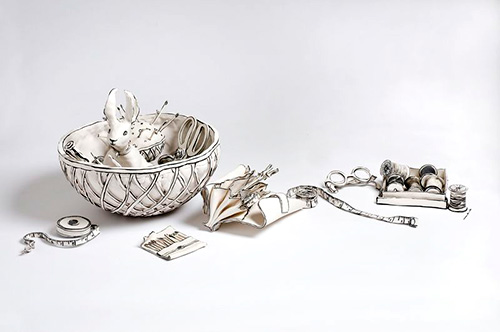
As I was making this piece I decided to put a rabbit in the basket, for me this is adding the element of surprise and delight, but for others this enables them to look at the work and overlay their own memories and fantasies of what this piece means to them. Often people will tell me a story of their own childhood or something very personal to them in response to the piece.
Last year I exhibited two small pieces at the Royal Academy Summer exhibition and found that the tape measure in particular, created a very strong emotional reaction with the viewer. I have my own personal reasons for creating measuring equipment but this was something that chimed very strongly with many of those that bought one of the series of 100. I received many emails and letters about what this piece meant to them with responses ranging from a life of domesticity, to a seamstress, to one man who felt that this summed up the measure of his life.This is where I feel a story is opened by me and continues with the viewer.
Your work is taken from everyday objects; can you discuss three pieces?
Poison pen
Poison pen was a direct reaction to my feelings about being dyslexic. I find that the words moving around my feelings of slight panic with anything to do with words. This piece is technically quite challenging, being one of the largest pieces I make from porcelain. It has an inner structure as porcelain will sag at high temperatures. Another challenging aspect was controlling the movement of the keys so that they have the illusion of appearing to wobble but without them falling over.
I was particularly pleased with how the keys came out, the heat of the kiln had moved the keys just enough to create a sensation of how I feel as a dyslexic with words. To me it summed up my feelings, and I didn’t feel the need to tell people what the piece means to me. Now the work has a new life of what it means to other people.
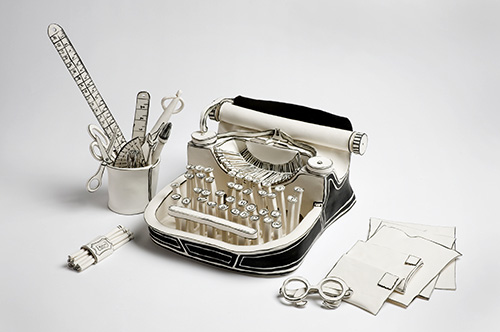
Plenty
Originally, I thought that this piece was about money, and then as it developed I thought it was about friendship. Actually I have no idea what this piece is about. Some pieces reveal themselves to me many years later. I am still waiting to know about this one.
On a technical level, this was slightly more challenging than Poison Pen as the piece had a cross work section inside to hold up the rounded front of the till.
As I was making the work, I kept adding more and more coins and even though it ended up having coins over the floor, it wasn’t enough. Maybe this piece should have been shown with half a room full of coins!
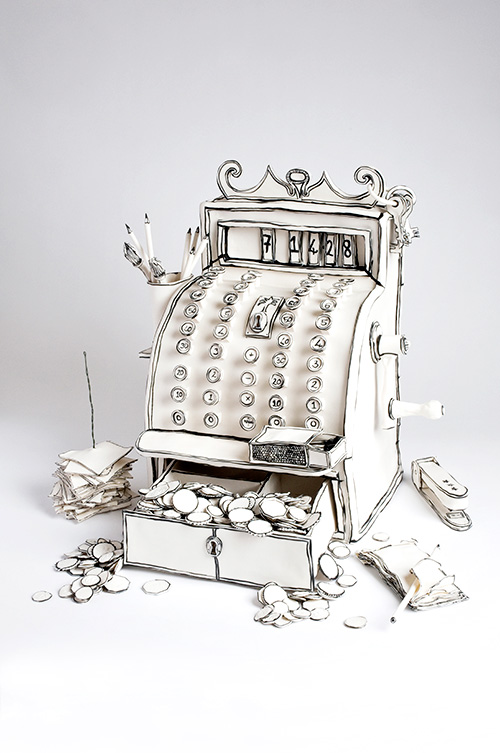
Morling and the Hoard
Morling and the Hoard was a project that I was very unsure about working on; it was a public art commission. My work is very personal to me, led by my personal narrative and this project was very much about responding to something from the 7th century, which I didn’t feel had a connection with.
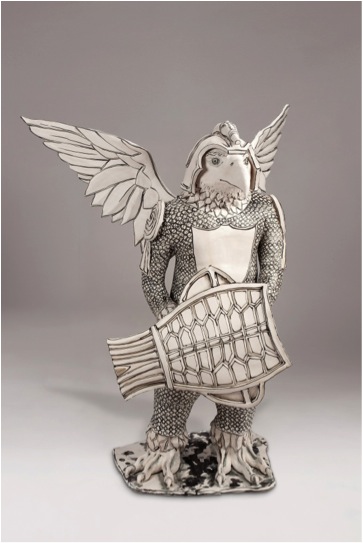
As we progressed with the work I realised this project is very much connected to me because each piece that I work on, takes a part of me into it. As I designed the pieces and created them in clay, I really formed a relationship with them and am very happy with the finished works.
Technically the pieces were very difficult as they were large-scale sculptures. However I found that the main technical difficulties were to do with managing the studio. I had to employ several other people to assist with the project and we had several other commissions running con currently. Studio management and balancing artistic direction was the most technically difficult part of this work.
Many viewing your work here will not realize the size, can you discuss this aspect of your work?
The first piece I created in my current style was a pair of scissors in porcelain. They were ‘life-size’ and created just the feeling I was looking for.
Very quickly I moved onto making a full size chair and table. I often like to work on large scale pieces but at the same time, I really enjoy working on tiny intimate pieces the size of a coin, a pin or a needle.
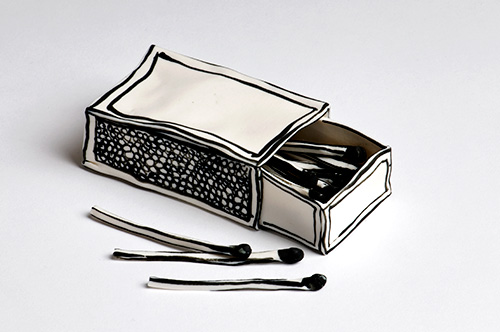
I enjoy the fact that some people will come to see my work expecting small table top pieces and discover a full size tree, a life size chair or figure. There is a lot of delight in their reaction.
Due to the size of your work, can you please take us into your studio space and explain some of the specific requirement you have for this space?
My studio is on two floors, I have a large kiln in the basement and studio space on the second floor, which is light and airy. The large scale pieces are created on wheelie boards. These are the same height as my kiln.
When I finish a piece, I move it downstairs while it is still in its green state to dry in the basement by the kiln. The work is built on kiln shelves with several layers of cardboard underneath. This means we can then slide the work on the shelf straight into the kiln. The smaller pieces are made in the studio and fired in a smaller kiln.
There is a great stop motion video that we made during Morling and the Hoard of the making process, which gives you an insight into the creation of the large works.
http://katharinemorling.co.uk/projects/stop-motion-video-of-morling-and-the-hoard
Originally your work was coloured, when and why did you move to monochromatic work?
I found that my current practice, no longer represented me emotionally and I wasn’t feeling connected to it, something was missing. I decided to apply to the Royal College of Arts to explore new directions and to re-connect with my work. There Felicity Alieff helped me to discover this new aesthetic.
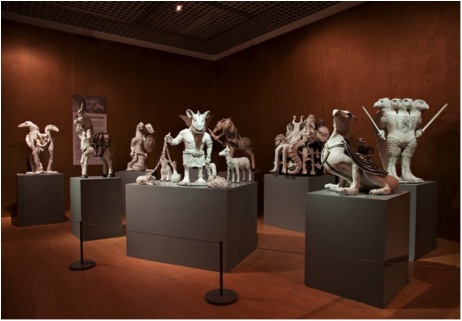
You have done many projects. Can you expand ontwo of your projects?
Waddesdon Manor – for the National Trust
I worked on the Waddesdon manor project while at the RCA. We had several live projects which means that there is a professional side of them. Sometimes this is creating work for an exhibition or in the case of Waddesdon Manor creating a product for their shop.
I went to WM and looked around and get a feel for the place. I found the house quite opulent and didn’t know where to begin but I loved the garden space so I started to draw it.
As I was drawing with my inky blue pen, it started to rain and I got quite smudgy drawings, which were quite pleasing.
I showed my tutor the drawings thinking that we would come up with an idea for a product, instead she turned to me and said “This is great, let’s get the drawings onto a plate or a cup…go back and do more drawings”. I was surprised and delighted that they loved my drawings and put them into production a cup and saucer and two plates.
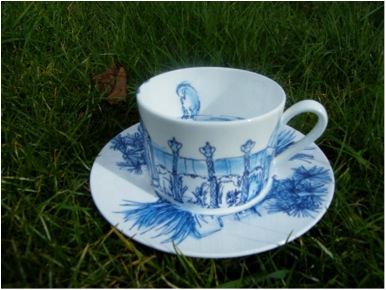
Osborne & Little – London Showroom
In conjunction with the Crafts Council, I was asked to put some of my work in a Kings Road shop. I decide to show part of ‘Stilted Life’, one of my large installations before it went to be exhibited at the World Crafts Council Second European Triennial of Ceramic and Glass in Mons and then to its permanent home in the Balman Collection. I received a lot of interest from Kings Road shoppers from that exhibition.
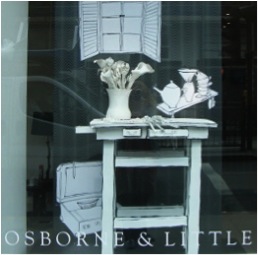
For the collector you also do smaller pieces. Can you expand on this part of your portfolio and these pieces?
Ball of Wool and Needles
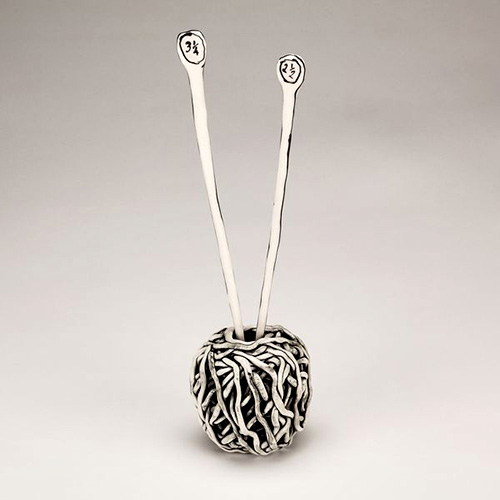
All the small works start life as part of a big installation. For example Chair maquette is a very small 10cm chair, which I would make in different designs before making a large scale chair. Often people will come in my studio, and see the smaller maquettes and ask to buy them. This gives the maquettes their own independent life, becoming part of the group of small works.
Ball of Wool came originally from A Stitch in Time. I have been asked for all the elements of the installation to be made individually for people.
Glasses
Glasses originally started as part of Poison Pen and once again I was asked to create each piece to be available individually.
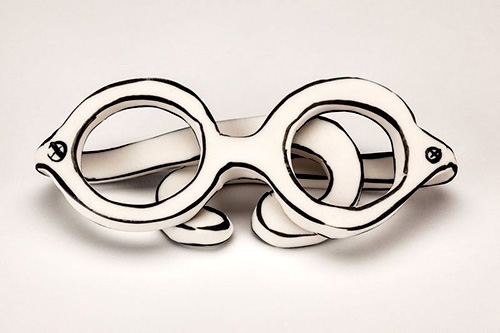
You do make pieces to order (commissions). How does this work?
Commissions work in two ways, all of the work I make is in a series. Large pieces are in a series of 10 and small works tend to be in a series of 100 or 200. This is really straightforward and anyone can commission the next edition in a series. The collector will then get a timescale of when the piece can be delivered.
The other route of commission is when I am given a brief to interpret or as with my work with the Balman gallery I am given a budget to which I create my own brief, which has been a very generous way of working.
On some commissioned pieces you add personal dedications – can you share one or two funny or clever ones?
Unfortunately no, dedications tend to be very personal often to do with a passed love one. Though I have had to do the odd 60th Birthday message!
Handbags – tell us about them?
Containers and vessels, contain more than just food and water. For me, they are containing emotions. The bag is a great place for my baggage.
Everyday Exploration for example contains all the measuring equipment for measuring and understanding life. However many devices I stuff into my handbag, some situations seem immeasurable.
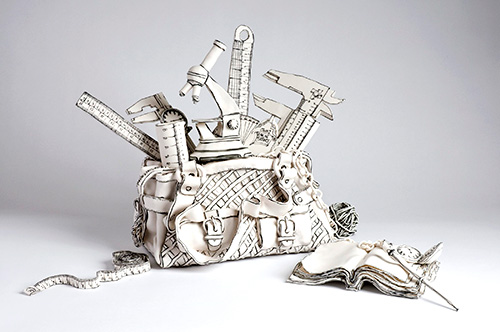
Your exhibition in Munich, “Cabinets of Nature and Curiosity”, can you discuss this?
I showed a piece called Butterfly Drawer, this was created in porcelain and black stain. For this piece, I was very interested in the concept of being close to nature and the feeling of dead and alive. I was approached to exhibit a piece of my work in February. The curator Dr. Michaela Braesel had seen some of my old work and was interested in my new pieces and thought they would sit well in the exhibition.
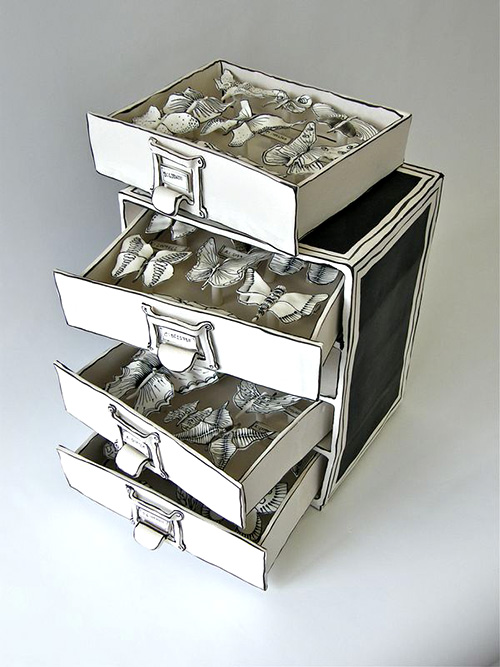
You also do classes – can you expand on your Design Making course?
For the DesignMake course, I teamed up with three other makers at Cockpit Arts, two textile artists and a glass maker to offer a range of creative courses. My sessions are actually less about designing and making and more about the feeling you get and the quietness that comes from touching clay.
My approach to teaching is entirely simple. I believe that everybody has innate creativity and that clay is a fantastic material to quieten down the mind, ground you and take you to a place where you can enjoy your creativity. I don’t teach this, it just happens.
Contact Details
Katharine Morling
Studio 205
18-22 Creekside
Deptford
London
SE8 3DZ
www.katharinemorling.co.uk
katharine.morling@network.rca.ac.uk
Katharine Morling, London, UK
Interview by Deborah Blakeley, July, 2013
Think a colleague or friend could benefit from this interview?
Knowledge is one of the biggest assets in any business. So why not forward this on to your friends and colleagues so they too can start taking advantage of the insightful information the artist has given?
Other artists you may be interested in:


